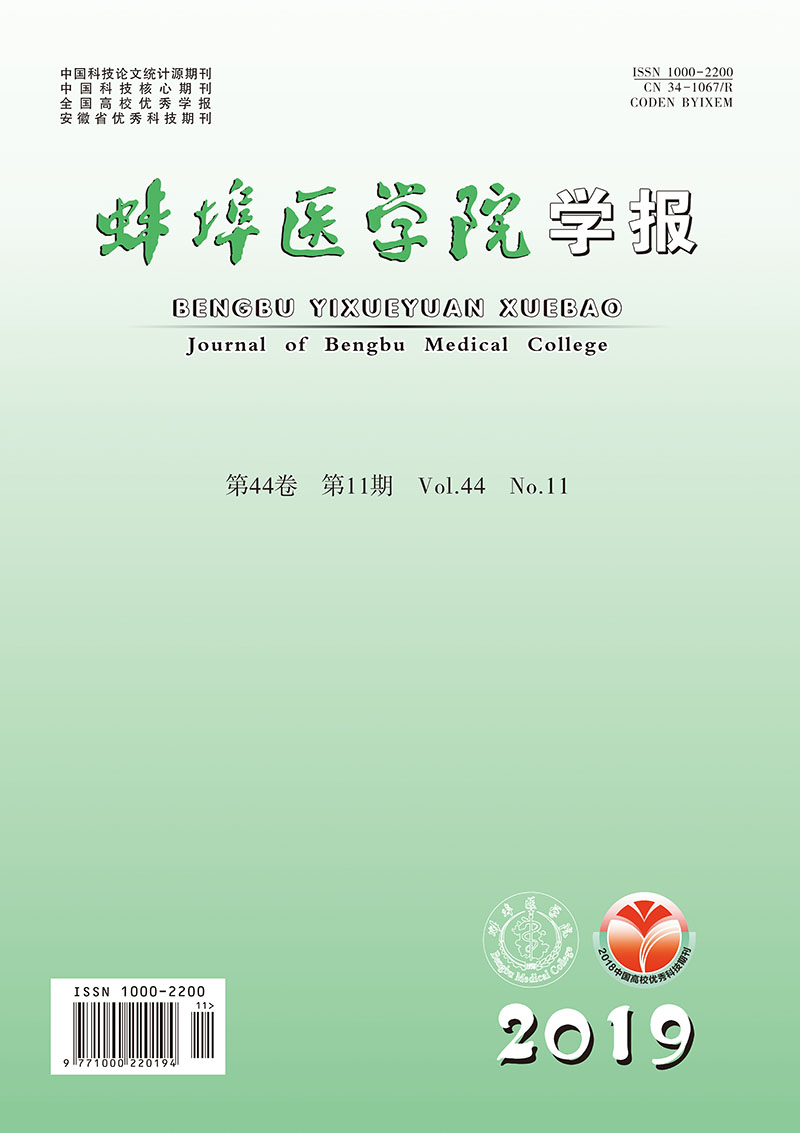-
有研究[1]表明心脏外科手术病人术后认知功能障碍(POCD)的发生率高达52%。POCD的特征性表现是麻醉和手术后认知功能的持续性下降,POCD的发生严重降低了病人术后的生活质量,如何降低心脏手术病人POCD的发生率成为临床医生迫切需要解决的问题。近红外光谱学(NIRS)局部脑氧饱和度(rSO2)监测技术可以作为预测术后认知功能结果的一个敏感指标,麻醉医生在NIRS rSO2数值下降时给予干预措施可以降低病人POCD发生率、缩短病人的住院天数[2]。目前国内关于应用NIRS rSO2监测技术降低心脏手术病人POCD发生率的研究鲜有报道。本研究拟通过对比将NIRS rSO2监测技术应用于二尖瓣置换术病人,旨在降低此类病人POCD的发生率,并探索较佳的NIRS rSO2干预措施。
HTML
-
选取60例择期行体外循环下冠脉搭桥手术或瓣膜置换手术病人,ASA分级Ⅱ~Ⅲ级,年龄20~65岁,体质量指数(BMI)17~30 kg/m2,术前通过医学伦理委员会认证,告知病人及其家属有关风险并签署知情同意书。采用随机数字表法将病人分为2组,NIRS rSO2干预组(T组,n=30)和常规监测组(C组,n=30)。排除术后需要进行体外膜肺氧合、术前高胆红素血症、多次重大手术史、术前存在神经系统疾病的病人。2组年龄、性别、ASA分级、手术方式、麻醉时间、体外循环时间、术前简易精神状态检查表(MMSE)评分等差异均无统计学意义(P>0.05)(见表 1)。
分组 年龄/岁 男 女 ASA分级 手术方式 麻醉时间/
min体外循环时间/min 术前MMSE
评分/分Ⅱ Ⅲ 冠脉搭桥 瓣膜置换 T组 58.8±5.53 21 9 20 10 11 19 319.70±31.91 123.13±20.32 28.93±0.87 C组 58.3±5.45 23 7 23 7 13 17 325.27±38.50 127.67±23.90 28.80±096 t 0.35 0.34△ 0.74△ 0.28△ 0.61 0.79 0.55 P >0.05 >0.05 >0.05 >0.05 >0.05 >0.05 >0.05 △示χ2值 -
2组病人入手术室后上肢建立静脉通道,接监护仪常规监测体温、心电图、无创血压、血氧饱和度(SpO2)、呼气末二氧化碳(PETCO2),随后局麻下行桡动脉穿刺置管测压术、局麻下右颈内静脉穿刺置管测压术;无创NIRS rSO2(Masimo-大脑功能监测)置于右侧或左侧额头,发射光点位于眉上2.0~2.5cm,探头边缘旁开额中线1 cm。麻醉诱导:依次静注咪达唑仑0.1 mg/kg、舒芬太尼2 μg/kg、依托咪酯0.2 mg/kg、顺苯磺酸阿曲库铵0.15 mg/kg。气管插管后行机械通气维持PETCO2 35~45 mmHg。麻醉维持:丙泊酚1~2 mg·kg-1·h-1、0.8肺泡气最低有效浓度(MAC)七氟醚吸入;间断静注舒芬太尼和顺苯磺酸阿曲库铵维持麻醉,使脑电双频指数监护仪(BIS)维持在40~60。建立体外循环:心脏主动脉、上下腔静脉插管后开始体外循环,调整变温箱水温维持术中鼻咽温度(32±1)℃,流量也随体温的下降降至2.0~2.2L·min-1·m-2, 待心内手术基本结束时调整变温箱温度复温,至鼻咽温度36~37℃时,缓慢还血停机。特殊处理:T组当rSO2数值降低至基线的11%时依次通过调整头部位置、确定主动脉上下腔静脉插管的位置、调整平均动脉压、动脉SpO2、动脉血二氧化碳、血红蛋白、混合SpO2于正常范围内将rSO2数值恢复至基线水平;C组则根据麻醉医生的经验使病人的生命体征维持在可以接受的水平。
-
记录2组麻醉开始前(T0)、麻醉诱导后5 min(T1)、体外循环开始(T2)、人工低温后10 min(T3)、人工低温后40 min(T4)、体外循环结束(T5)、关胸(T6)时NIRS rSO2数值;每分钟记录2组NIRS rSO2数值1次,汇总后计算NIRS rSO2均值(rSO2avg)、最小值(rSO2 min),较基础值降低的最大百分比(rSO2%max)。采集2组T0、T2、T4、T6时颈内静脉血液检测神经元特异性烯醇化酶(NSE)、S100β蛋白的含量。2组于术前1 d(M0)和术后第3天(M3)、第7天(M7)使用MMSE评估其认知功能,术后MMSE评分较术前基础值下降≥2分则认为发生POCD。
-
采用t检验和χ2检验。
1.1. 一般资料
1.2. 方法
1.3. 观察指标
1.4. 统计学方法
-
2组在T0、T1、T2、T6时间点NIRS rSO2差异无统计学意义(P>0.05);T组在T3、T4、T5时间点NIRS rSO2数值要高于C组(P < 0.01)(见表 2)。
分组 T0 T1 T2 T3 T4 T5 T6 T组 73.10±2.45 82.50±4.25* 74.03±2.53 81.0±4.73 82.43±36 80.90±3.38 77.93±4.01 C组 73.33±3.02 83.93±3.42* 73.90±2.41 70.80±3.14 73.0±3.06 76.37±3.93 77.43±3.14 t 0.32 1.44 0.20 9.84△ 11.37 4.79 0.54 P >0.05 >0.05 >0.05 <0.01 <0.01 < 0.01 >0.05 △示t′值;与T0比较*P < 0.05 -
T组rSO2avg、rSO2min的值高于C组(P < 0.01),rSO2%max的值明显低于C组(P < 0.01)(见表 3)。
分组 rSO2avg rSO2min rSO2%max T组 80.83±3.50 74.57±2.88 6.83±2.45 C组 75.13±2.75 70.53±3.07 14.30±3.01 t 7.01 5.26 10.54 P < 0.01 < 0.01 < 0.01 -
2组NSE、S100β蛋白含量在T0时间点差异均无统计学意义(P>0.05),T组在T2、T4、T6时间点S100β蛋白数值低于C组(P < 0.01),在T2、T4、T6时间点NSE蛋白数值低于C组(P < 0.01)(见表 4)。
指标 分组 T0 T2 T4 T6 S100β蛋白/(μg/L) T组 0.21±0.05 0.62±0.12 0.74±0.08 0.55±0.14* C组 0.23±0.06 1.12±0.26 1.41±0.17 0.93±0.22* t 1.40 9.56△ 19.53△ 7.98△ P >0.05 < 0.01 < 0.01 < 0.01 NSE/(μg/L) T组 5.73±1.12 12.89±2.51 13.47±2.66 11.43±2.06* C组 6.05±1.24 22.21±3.23 23.77±3.27 21.28±3.02* t 1.05 12.48 13.38 14.76△ P >0.05 < 0.01 < 0.01 < 0.01 △示t′值;与T0比较*P < 0.05 -
2组在M0时间点MMSE评分差异无统计学意义(P>0.05);T组在M1、M3、M7时间点MMSE评分高于C组(P < 0.05~P < 0.01)(见表 5)。T组POCD发生率17%(5例),低于C组的43%(13例)(χ2=5.08,P < 0.05)。
分组 M0 M1 M3 M7 T组 28.93±0.87 25.83±1.12 26.77±1.04 28.03±0.89 C组 28.80±096 24.50±1.25 26.13±0.97 26.77±0.86 t 0.55 4.34 2.46 5.57 P >0.05 < 0.01 < 0.05 < 0.01
2.1. 2组不同时间点NIRS rSO2数值比较
2.2. 2组rSO2avg、rSO2min、rSO2%max比较
2.3. 2组不同时间点NSE、S100β蛋白含量比较
2.4. 2组不同时间点的MMSE评分比较
-
POCD是术后常见并发症之一,其临床表现为认知能力减退、焦虑、记忆受损、语言理解能力和社会融合能力减退,严重时影响独立生活能力。其发生机制目前仍未完全明了[3],如何在保障手术安全的同时降低POCD的发生率是麻醉医生亟需解决的问题之一。
有研究[4-5]表明, 若病人术中NIRS rSO2数值较低并持续一定的时间,病人术后发生苏醒延迟的概率就会大大增加;心脏外科手术中NIRS rSO2数值若低于术前基线值20%并持续一定的时间,术后病人则有可能发生神经系统的不良后果[6-7]。NIRS rSO2方法运用了近红外光谱技术,临床医生将监测探头正确固定于病人的前额后,探头发出的近红外光可以穿透颅外皮肤、颅骨进入脑组织,脑组织中处于不同氧化状态的血红蛋白吸收光谱的程度有差别,近红外光穿透血红蛋白的程度就会出现差异,这种差异经过数字化处理就最终得到rSO2数值。该监测技术不依赖动脉脉搏,具有较高稳定性,对体温过低、血压过低、甚至心脏骤停等血流流动力学不稳定的病人仍然可以获得稳定的NIRS rSO2数值[8-9]。NIRS rSO2测定作为一种简单、无创、可持续的局部rSO2检测手段,在指导麻醉医生临床实践活动具有重要意义,本研究将NIRS rSO2监测技术应用体外循环下心脏外科手术的病人,通过术中干预措施降低其POCD的发生率,结果显示,2组T1时间点NIRS rSO2数值较T0时间点有明显的升高,可能是由于全麻诱导时吸入高浓度的氧和静脉麻醉药降低了脑耗氧量所引起的,与DESCHAMPS等[10]研究结果相一致;在T3、T4、T5时间点C组的rSO2数值要低于T组,说明麻醉医生术中NIRS rSO2干预措施起到了脑保护作用。NIRS rSO2测定数值具有很大的个体差异性,并且其数值受皮肤色素沉着、体位变化、不同厂家的校准方式等因素影响,故本研究中加入rSO2%max进一步来探讨NIRS rSO2监测技术的实用性,本研究中T组rSO2avg、rSO2min的数值高于C组,T组rSO2%max低于C组,证实了术中干预NIRS rSO2的有效性;目前国际上仍然没有干预NIRS rSO2数值的指南,本研究中的干预措施参考了DESCHAMPS等[10]大样本统计研究,在T组NIRS rSO2数值下降至基线值的11%(亦有研究在NIRS rSO2数值降低至基线值20%时给予干预措施,本研究参考DESCHAMPS等[10]研究,为保证病人安全,在NIRS rSO2数值降低至基线值11%时给予干预措施)时依次通过干预头部位置、主动脉插管的位置、平均动脉压、动脉血氧饱和度、动脉血二氧化碳、血红蛋白、混合血氧饱和度、脑耗氧量来提高NIRS rSO2数值,证实此类NIRS rSO2指导下干预措施在心脏手术中的有效性。
相关研究[11]表明S100β蛋白、NES数值和POCD的发生率呈一致性,本研究中2组S100β蛋白、NSE数值在T0时间点时差异无统计学意义,T2、T4时2组的S100β蛋白、NSE数值明显高于T0时间点,在T6时间点时其数值有降低,但仍然高于T0时间点;在T2、T4、T6时间点时T组S100β蛋白、NSE数值要低于C组,T组的POCD的发生率低于C组,进一步佐证了NIRS rSO2监测技术和麻醉医生术中的干预措施可以改善病人的预后。MMSE评分量表是目前国内最常用的判断POCD发生的工具,2组M1、M3、M7时间点MMSE评分高于C;T组POCD的发生率要明显低于C组。
综上所述,NIRS rSO2监测技术和术中恰当的NIRS rSO2干预措施可以降低心脏手术病人POCD的发生率,值得临床推广。






 DownLoad:
DownLoad: